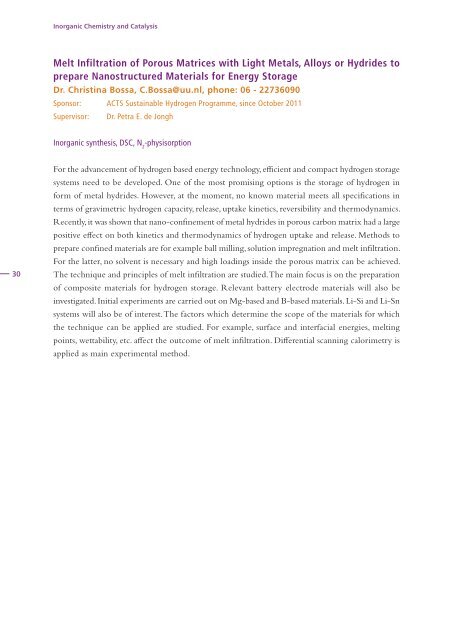Debye Institute for Nanomaterials Science
Debye Institute for Nanomaterials Science
Debye Institute for Nanomaterials Science
You also want an ePaper? Increase the reach of your titles
YUMPU automatically turns print PDFs into web optimized ePapers that Google loves.
30<br />
Inorganic Chemistry and Catalysis<br />
Melt Infiltration of Porous Matrices with Light Metals, Alloys or Hydrides to<br />
prepare Nanostructured Materials <strong>for</strong> Energy Storage<br />
Dr. Christina Bossa, C.Bossa@uu.nl, phone: 06 - 22736090<br />
Sponsor: ACTS Sustainable Hydrogen Programme, since October 2011<br />
Supervisor: Dr. Petra E. de Jongh<br />
Inorganic synthesis, DSC, N 2 -physisorption<br />
For the advancement of hydrogen based energy technology, efficient and compact hydrogen storage<br />
systems need to be developed. One of the most promising options is the storage of hydrogen in<br />
<strong>for</strong>m of metal hydrides. However, at the moment, no known material meets all specifications in<br />
terms of gravimetric hydrogen capacity, release, uptake kinetics, reversibility and thermodynamics.<br />
Recently, it was shown that nano-confinement of metal hydrides in porous carbon matrix had a large<br />
positive effect on both kinetics and thermodynamics of hydrogen uptake and release. Methods to<br />
prepare confined materials are <strong>for</strong> example ball milling, solution impregnation and melt infiltration.<br />
For the latter, no solvent is necessary and high loadings inside the porous matrix can be achieved.<br />
The technique and principles of melt infiltration are studied. The main focus is on the preparation<br />
of composite materials <strong>for</strong> hydrogen storage. Relevant battery electrode materials will also be<br />
investigated. Initial experiments are carried out on Mg-based and B-based materials. Li-Si and Li-Sn<br />
systems will also be of interest. The factors which determine the scope of the materials <strong>for</strong> which<br />
the technique can be applied are studied. For example, surface and interfacial energies, melting<br />
points, wettability, etc. affect the outcome of melt infiltration. Differential scanning calorimetry is<br />
applied as main experimental method.






